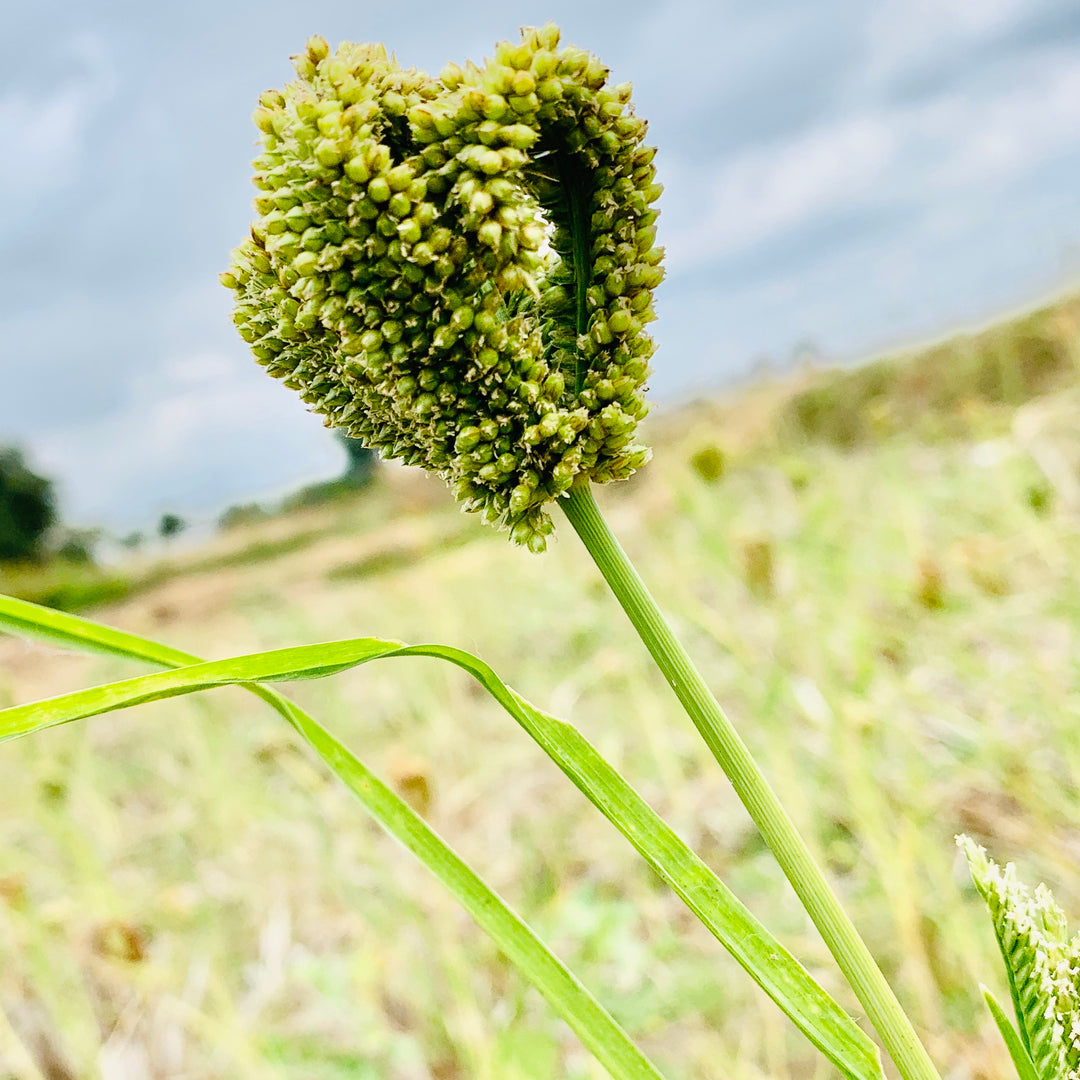Local Name: Ragi, Mandal, Mandua, Kodra, Koda
Major Farming Areas: Sirmaur, Shimla, Kullu, Mandi, Solan, Chamba, Kangra, Lahaul-Spiti and Kinnaur
Finger Millet (Eleusine coracana), also known as ragi, mandala is one of the most important coarse cereal crops grown in Himachal Pradesh. Ragi is a staple food in many regions of the state. This crop has excellent storage properties and is resistant to the outbreak of pests. Due to all these qualities, the grains of this crop are being stored for the situation arising like shortage of food grains and famine.
There are two commonly grown varieties of Ragi i.e, black-seeded and white-seeded, the white-seeded variety is preferred for food, but both varieties can be used for cattle feed.



Nutritional Properties
Ragi contains carbohydrates, proteins, fibre and minerals, which is either equal to or more than found in Rice, Wheat, Maize and other coarse Millet. Its protein profile is well balanced. In addition to minerals such as calcium, Iron, Potassium, Magnesium and Zinc, it also contains Vitamin B, especially Niacin, B6 and Folic Acid. It is a good source of natural Iron.
Amount of Nutrients
| Nutrients | Nutritional Value per 100 grams |
| Moisture | 10.89 g |
| Protein | 7.16 g |
| Fat | 1.92 g |
| Fibre | 11.18 g |
| Carbohydrates | 66.82 g |
| Potassium | 0.44 mg |
| Phosphorus | 0.21 mg |
| Magnesium | 0.15 mg |
| Calcium | 0.36 mg |
| Iron | 0.004 mg |
| Energy | 1342 Kilo Joule |
| Source: CSK Himachal Pradesh Agriculture university, Palampur | |
Health Benefits
- Strong Bones and Teeth
Ragi contains 3 times more calcium than milk. Calcium is necessary to keep bones and teeth strong. It is good for growing children as well as elderly people who may be at risk of osteoporosis.
- For Weight Loss
Ragi has very little natural fat which makes it suitable for weight loss. It contains Tryptophan Amino Acid which helps in controlling our body weight by reducing appetite. Ragi has a slow digestion rate, this keeps us away from consuming excess calories in our diet.
- Controls Diabetes
It helps in regulating blood sugar levels. It has a low glycemic index which promotes slow digestion and prevents blood sugar levels from rising in the body.
- For Pregnant and Lactating Women
Consumption of Ragi helps in healthy pregnancy by providing relief from anxiety and stress. The minerals and nutrients of Ragi help in providing nutrition and immunity to the mother and baby during pregnancy.
- Good Skin
It helps in maintaining the glow of the skin and prevents the formation of wrinkles and sagging.
- Healthy Heart
The presence of fiber in Ragi helps in reducing cholesterol. Lecithin and methionine remove excess fat from the liver and stabilize cholesterol levels in the blood.
- Maintains Hemoglobin Levels
Ragi is a good source of natural iron which has a positive effect on hemoglobin levels.
- Improves Digestion
Fibre rich Ragi helps a lot in keeping the digestive system healthy.
- Regular consumption of Ragi is useful in dealing with the problems of depression, insomnia, migraine and anxiety.
Ragi Cultivation
Ragi crop requires less investment. Due to its ability to tolerate abnormal conditions, dry land is also suitable for farming.
Climate
Ragi can also be grown in areas at an altitude of more than 2000 meters above sea level. An average temperature of 26-29°C is required for proper growth and development.
Soil
Ragi is cultivated in soils ranging from good loamy soil to shallow upland soil. It can be grown in well drained loamy and sandy loam soils with high fertility and water holding capacity.
Recommended Varieties for Himachal Pradesh
V.L.-117, V.L.-204 and V.L.-115 are high yielding varieties of Ragi with short duration.
Sowing Time
The time from first week to third week of May is suitable for sowing. The recommended row to row distance for sowing is 22-30 cm and the plant to plant distance is 8-10 cm. The seeds should be sown at a depth of 2-3 cm. The recommended Seed rate for sowing is 4-5 Kg/Ha. Sowing can also be done by broadcasting method.
Manure and Fertilizer
Apply cow farmyard manure (FYM) at the rate of 8-10 tonnes per hectare at the time of land preparation. The recommended quantities of fertilizers are 40 kg Nitrogen, 20 kg Phosphorus and 20 kg Potassium per hectare. Apply full quantity of phosphorus and potassium and half quantity of nitrogen at the time of sowing and half quantity of nitrogen 40-45 days after sowing.
Weed Control
Two weeding should be done in the crop. It is advisable to do the first weeding at the time of thinning and the second weeding in mid-July.
Irrigation
In areas with low rainfall, if irrigation facility is available then irrigation twice is recommended.
Crops Harvesting
This crop does not ripen evenly, hence harvesting should be done in two stages. When 50 percent of the ears on the crop turn brown, the crop is ready for the first harvest. The second harvest takes place approximately seven days after the first harvest. The crop is collected and kept in a heap in the shade for a day without drying it. After this the harvested crop is dried, crushed and the seeds are cleaned. This crop provides an average grain yield of 10 quintals per hectare and fodder yield of 6-8 quintals per hectare.
Usage
Ragi is mainly used for the preparation of traditional food items like roti (unleavened bread or pancake), mudde (dumplings), ambali (thin porridge), laddu, dosa, cookies and malts. The use of sprouted grains is also recommended for children and the old age people. Ragi plant residues are used as animal fodder. The straw is also used to make baskets, mats and roof thatch.
Value Added Products of Finger Millet
Ragi Biscuit

| Material | Quantity | Method |
| Ragi Flour | 1/2 Cup |
|
| Wheat Flour | 1/2 Cup | |
| Powdered Sugar/ Jaggery | 1/2 Cup | |
| Cardamom Powder | 1/4 Table Spoon | |
| Ghee | 6-8 Table Spoon | |
| Baking Powder (optional) | 1/2 Table Spoon | |
| Milk | 2 Table Spoon |
Ragi Laddu

| Material | Quantity | Method |
| Ragi Flour | 1 Cup |
|
| Wheat Flour | 1/2 Cup | |
| Cashew | 8 | |
| Cardamom Powder | 1 Pinch | |
| Jaggery | 3/4 Cup | |
| Ghee | 3 Spoons |



